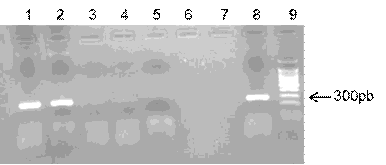Diagnosis of Xanthomonas albilineans (Ashby) Dowson by Tissue Blot Immunosorbent Assay
Main Article Content
Abstract
Leaf scald is one of the major diseases of sugarcane in the world. It causes severe losses in both agricultural and industrial yields. During years, visual analysis was the mechanisms for disease diagnostic. Achieve of this paper was to apply the tissue impression immunological technique (TBIA) for the diagnosis of X. albilineans. Leaves of susceptible cultivars Co3-551, C90-176 y PR980 were positive controls, while C86-56 was the negative, confirmed by PCR (polymerase chain reaction) using specifics primers for Xa. For TBIA the leaves were press over a nitrocellulose membrane and leaf dried at room temperature. Different dilutions and combination of the specifics antiserum anti-mouse-Xanthomonas albilineans (Xalb) and anti-mouse for Xalb conjugated with alkaline phosphatase from “agdia” were used. Dark blue stain color was showed over the nitrocellulose membranes where the vascular bundles were imprinted in susceptible cultivars, while no color was observed in negative control. Best results were observed with the specifics antiserum anti-Xalb diluted 1/1500 and the anti-mouse for Xalb conjugated with alkaline phosphatase diluted 1/3500.
Article Details

This work is licensed under a Creative Commons Attribution-NonCommercial 4.0 International License.
References
Alvez, B., Alonso, G., & Oropeza, M. (2016). Genotipificación y perfil bioquímico de aislados de xanthomonas albilineans en Venezuela. Interciencia, 41(11), 732-739, ISSN: 0378-1844.
Funes, C., Acosta, E., & Ramallo, C. (2009). Principales enfermedades en caña de azúcar [Manual del Cañero, Las Talitas, Tucumán, Argentina, pp. 125-127].
García, J. H. S., Ortiz, G. C. F., Salgado, G. S., Valdez, B. A., Silva, R. H. V., & Ovalle, S. W. R. (2015). Presencia de Xanthomonas albilineans (Ashby) Dowson en caña de azúcar en La Chontalpa, Tabasco, México. Revista fitotecnia mexicana, 38(4), 397-404. https://doi.org/DOI: https://dx.doi.org/10.35196/rfm.2015.4.397, ISSN: 0187-7380.
Jorge, H., Jorge, I. M., Mesa, J., & Bernal, N. (2011). Normas y Procedimientos del Programa de Fitomejoramiento de la Caña de Azúcar en Cuba [Ediciones PUBLINICA, La Habana, Cuba, pp. 308-346].
López, V. J. J., Valdez, B. A., Silva, R. H. V., Flores, R. C., & Rangel, O. C. A. (2016). Evaluación a la escaldadura (Xanthomonas albilineans (Ashby) Dowson) de la hoja de variedades de caña de azúcar (Saccharum spp.). Agroproductividad, 9(3), 48-54.
Ntambo, M. S., Meng, J. Y., Rott, P. C., Royer, M., Lin, L. H., Zhang, H. L., & Gao, S. J. (2019). Identification and characterization of Xanthomonas albilineans causing sugarcane leaf scald in China using multilocus sequence analysis. Plant Pathology, 68(2), 269-277, ISSN: 0032-0862.
Pan, Y. B., Grisham, M. P., Burner, D. M., Legendre, B. L., & Wei, Q. (1999). Development of polymerase chain reaction primers highly specific for Xanthomonas albilineans, the causal bacterium of sugarcane leaf scald disease. Plant disease, 83(3), 218-222, ISSN: 0191-2917.
Peralta, E., Martínez, B., Martín, D., & Jones, P. (1997). Quality control for the production of pathogen-free plantlets in Cuban sugarcane biofactories. ISSCT Pathology and Molecular Biology Workshop, South Africa.
Pieretti, I., Pesic, A., Petras, D., Royer, M., Süssmuth, R. D., & Cociancich, S. (2015). What makes Xanthomonas albilineans unique amongst xanthomonads? Frontiers in plant science, 6, 289. DOI: https://dx.doi.org/10.3389/fpls.2015.00289, ISSN: 1664-462X.
Ponte, E., Silveira, S., Barros, J., & Moreira, R. (2010). Incidencia de Leifsonia xyli subsp. Xyli en áreas de producción de caña de azúcar en Espíritus Santo, sur de Bahia y oeste de Minas Gerais. Summa Phytopathologica, 36(4), 313-321.
Zia, U. H. S., Rauf, C. A., Haque, M. I., Afghan, S., Fauconnier, T., Andrade, F. H., Shah, M. K. N., & Shahazad, A. (2013). Comparison of DAC-ELISA and Tissue Blot Immunoassay for the detection of Acidovorax avenae subsp. Avenae, causal agent of red stripe of sugarcane. J. Plant Pathol. Microb, 4, 172-175, DOI: https://dx.doi.org/10.4172/21577471.1000172.
